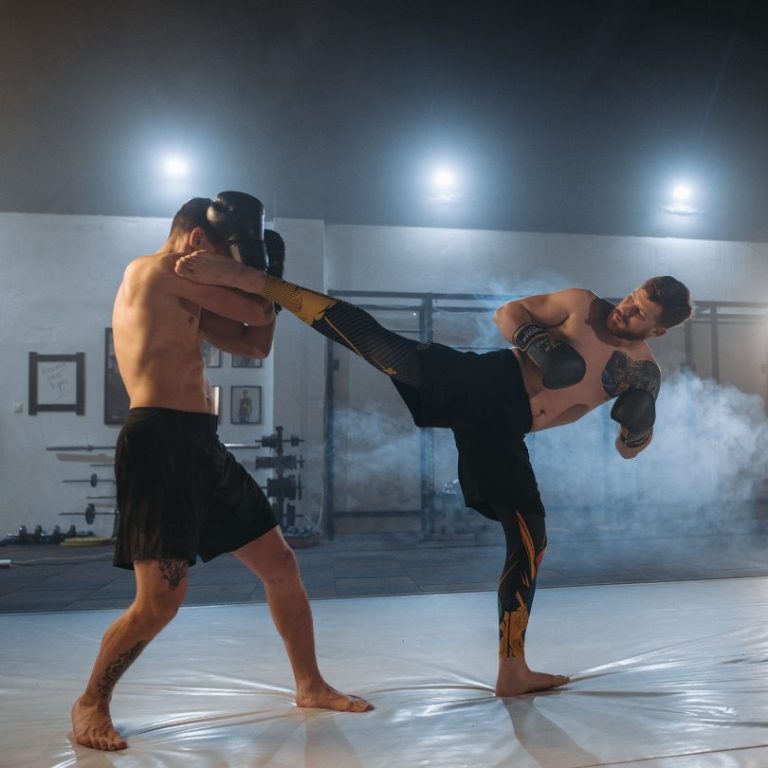Have you ever watched a UFC fight and thought, “Wow, how do these incredible athletes even get there?” It’s a question many new fans ask, and for good reason! Becoming a UFC fighter isn’t like joining a local sports team; it’s one of the toughest and most challenging journeys in the world of professional sports.
It takes years of dedication, incredible talent, and a whole lot of grit. Let’s break down the path that aspiring martial artists take to reach the pinnacle of mixed martial arts: the UFC Octagon.
Phase 1: Building the Foundation – The Early Years of Discipline
Every UFC champion or contender started somewhere, and for most, it began long before they ever dreamed of the big lights.
Starting Young (Often, But Not Always!):
Many future UFC stars begin their martial arts journey as kids or teenagers. They might start with a single discipline like wrestling, boxing, Brazilian Jiu-Jitsu (BJJ), Muay Thai, karate, or judo. Think of it like learning to walk before you can run; mastering one style gives them a strong base. This early start helps them develop fundamental skills, discipline, and a deep understanding of combat.
Dedication to Training: More Than a Hobby:
For these individuals, martial arts quickly becomes more than just an after-school activity. It transforms into a lifestyle. They commit to intense physical conditioning, building strength, endurance, and flexibility. But it’s not just about physical power; it’s about learning the intricate techniques of various martial arts styles – how to strike effectively, how to grapple on the ground, and how to wrestle an opponent. It’s a continuous learning process.
Finding the Right Gym and Coaches:
This step is absolutely crucial. To become truly elite, aspiring fighters need to train at a top-tier MMA gym. These gyms are often filled with other professional fighters, experienced coaches, and specialized trainers for every aspect of MMA. Having the right coaches who understand their strengths and weaknesses, and training partners who push them to their limits, is essential for growth.
Phase 2: Gaining Experience – The Amateur and Regional Pro Circuit
Once a fighter has a solid foundation, they need to start testing their skills against others. This happens in the world of amateur and regional professional fights.
The Amateur Career: Learning the Ropes:
Before jumping into professional fights, many athletes compete as amateurs. These fights are usually shorter, with more protective gear, and focus on gaining experience without the pressure of a professional record. It’s their first taste of competing under the bright lights, managing nerves, and executing techniques when it truly matters. They learn to perform under pressure and start building a basic win-loss record.
Turning Professional: Stepping Up the Game:
After proving themselves as amateurs, fighters make the leap to professional MMA. This means longer fights, fewer protective measures, and a public record that truly counts. They compete in smaller, regional promotions – local shows, state-level leagues, or even national organizations that aren’t the UFC. The goal here is to build an impressive “professional record” (like 5 wins and 0 losses, or 8 wins and 1 loss). A strong record shows they can consistently win against tough opponents.
Getting Noticed: Catching the Eye of the Big Leagues:
This is where the hard work starts to pay off. UFC scouts and matchmakers (the people who decide who fights whom) are constantly watching these regional shows. They’re looking for fighters with exciting styles, dominant wins (especially knockouts or submissions), and a strong presence. Consistency and staying active are key; the more they fight and win, the more likely they are to catch the attention of the UFC.
Phase 3: The Gateway to the UFC – Making the Jump
Once a fighter has built a name for themselves on the regional scene, there are a few main ways they can get signed to the UFC:
Dana White’s Contender Series (DWCS): The Modern Pathway:
This is arguably the most common and exciting way for aspiring fighters to enter the UFC today. DWCS is a weekly show where promising prospects compete in front of UFC President Dana White himself. If a fighter puts on an outstanding performance – a dominant knockout, a slick submission, or an incredibly exciting fight – they can earn a direct UFC contract on the spot! Many of the UFC’s current fan favorites and champions, like Sean O’Malley, got their start through DWCS.
Being Signed from Other Major Promotions:
Sometimes, the UFC will sign already established champions or top contenders from other big MMA organizations around the world (like Bellator, ONE Championship, or the Professional Fighters League – PFL). These fighters have already proven they can compete at a very high level, and the UFC brings them in to bolster their roster and create exciting new matchups.
Filling Last-Minute Spots: The “Short-Notice” Opportunity:
Occasionally, a fighter with a good record might get a call from the UFC on very short notice (sometimes just a few days!) to step in for an injured fighter. This is a massive opportunity. While incredibly challenging, if they perform well, it can lead to a full UFC contract. It’s a high-risk, high-reward scenario.
Phase 4: Life as a UFC Fighter – Staying at the Top
Getting into the UFC is one challenge; staying there is another!
The Contract and The Pressure:
Fighters sign multi-fight contracts with the UFC. This means they’re officially part of the elite, but the pressure to win is constant. The UFC is a meritocracy – you need to keep performing and winning to stay employed.
The Grind Continues (and Intensifies):
Life as a UFC fighter involves even more intense training camps for each upcoming fight. They adhere to strict diets, manage their weight (often involving extreme “weight cuts” as discussed in previous articles), and dedicate countless hours to honing their skills. Beyond training, they also have media obligations, interviews, and public appearances.
Staying on the Roster:
Losing streaks can lead to a fighter being “cut” or released from their contract. The UFC constantly evaluates its roster, and only the best of the best remain. This creates a continuous cycle of fighting, recovering, training, and repeating, all while under immense scrutiny.
Key Qualities Needed to Become a UFC Fighter
Beyond just physical talent, becoming a UFC fighter requires a unique blend of qualities that set them apart:
Exceptional Athleticism:
This is the foundation. Fighters need a powerful combination of raw strength to overpower opponents, explosive speed for quick strikes and movements, incredible endurance to last through grueling rounds, and fluid agility to evade attacks and execute complex techniques. This isn’t just about looking strong; it’s about functional fitness that translates directly into fighting ability.
Technical Skill and Adaptability:
It’s not enough to be good at one martial art. UFC fighters must master various disciplines – being able to strike effectively (boxing, Muay Thai, kickboxing), wrestle proficiently (takedowns, takedown defense), and grapple at an elite level (Brazilian Jiu-Jitsu for submissions and ground control). The best fighters are also highly adaptable, able to switch between styles seamlessly and adjust their strategy mid-fight.
Mental Toughness and Resilience:
This is arguably as important as physical prowess. Fighters face immense pressure, both inside and outside the Octagon. They need:
-
- Discipline: To stick to brutal training regimens and strict diets.
- Resilience: To bounce back from losses, injuries, and setbacks without giving up.
- Composure Under Pressure: To perform their best when millions are watching and an opponent is trying to knock them out.
- Strategic Thinking: To analyze opponents and execute game plans.
Unwavering Work Ethic:
The journey is long and hard. UFC fighters have a relentless drive to train harder, learn more, and constantly improve. They often spend years perfecting their craft, making sacrifices that most people wouldn’t dream of. This means countless hours in the gym, drilling techniques, sparring, and conditioning.
Sacrifice:
Becoming a UFC fighter demands enormous personal sacrifice. This includes giving up many normal life experiences, social events, and personal comforts. Their diet is strict, their training schedule is demanding, and their focus must remain almost entirely on their career. It’s a life dedicated to the sport.
Charisma and Marketability (Increasingly Important):
While not a direct fighting skill, in today’s UFC, having a compelling personality, being good at interviews, and engaging with fans on social media can significantly boost a fighter’s career. It helps them gain popularity, secure bigger fights, and attract sponsorships.
Conclusion
The journey to becoming a UFC fighter is a long, arduous, and incredibly competitive one. It starts with a passion for martial arts, progresses through countless hours of training and smaller competitions, and culminates in a shot at the biggest stage in MMA. It’s an elite achievement that speaks volumes about the dedication, skill, and sheer will of the athletes who step into the Octagon.
Frequently Asked Questions (FAQ)
Q: How old do you have to be to fight in the UFC?
A: Generally, fighters must be at least 18 years old to compete professionally. Most fighters are in their 20s and 30s when they reach the UFC, with peak performance often seen in the late 20s to mid-30s.
Q: Do UFC fighters get paid well?
A: Pay varies hugely in the UFC. Top stars and champions can earn millions per fight, including bonuses and sponsorships. However, newer fighters or those on the preliminary cards might earn much less, sometimes only tens of thousands per fight, which needs to cover their training camps, coaches, and living expenses.
Q: How many fights do UFC fighters have in a year?
A: It varies, but most active UFC fighters compete 2-3 times per year. Some might fight more (4 times), while others might fight less (once) due to injuries, fight cancellations, or strategic breaks.
Q: Is it dangerous to be a UFC fighter?
A: Yes, MMA is a combat sport and carries inherent risks, including concussions, broken bones, cuts, and other injuries. However, the UFC and athletic commissions have many safety protocols in place (like medical screenings, on-site doctors, and quick referee stoppages) to minimize severe harm. No fighter has died inside the Octagon during a UFC-sanctioned fight.
Q: Can anyone become a UFC fighter?
A: While anyone can train in martial arts, becoming a UFC fighter requires an extremely rare combination of natural talent, athletic ability, mental fortitude, and unwavering dedication. It’s a dream for many, but achieved by very few.


